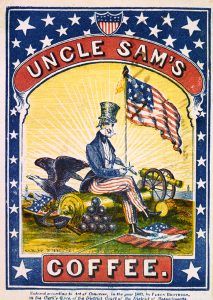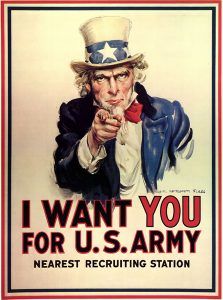The Origin of Uncle Sam
Although Uncle Sam (initials U.S.) is the most popular personification of the United States, many Americans have little or no concept of his origins. If pressed, the average American might point to the early 20th century and Sam’s frequent appearance on army recruitment posters. In reality, however, the figure of Uncle Sam dates back much further. Portraying the tradition of representative male icons in America, which can be traced well back to colonial times, the actual figure of Uncle Sam dates from the War of 1812.
At that point, most American icons had been geographically specific, centering most often on the New England area. However, the War of 1812 sparked a renewed interest in national identity which had faded since the American Revolution.
The term Uncle Sam is said to have been derived from a man named Samuel Wilson, a meat packer from Troy, New York, who supplied rations for the soldiers during the War of 1812. Samuel Wilson, who served in the American Revolution at the age of 15, was born in Massachusetts. After the war, he settled in the town of Troy, New York, where he and his brother, Ebenezer, began the firm of E. & S. Wilson, a meatpacking facility. Samuel was a man of great fairness, reliability, and honesty, who was devoted to his country. Well, liked, local residents began to refer to him as “Uncle Sam.”
During the War of 1812, the demand for meat supply for the troops was badly needed. Secretary of War, William Eustis, made a contract with Elbert Anderson, Jr. of New York City to supply and issue all rations necessary for the United States forces in New York and New Jersey for one year. Anderson ran an advertisement on October 6, 1813, looking to fill the contract. The Wilson brothers bid for the contract and won. The contract was to fill 2,000 barrels of pork and 3,000 barrels of beef for one year. Situated on the Hudson River, their location made it ideal to receive the animals and to ship the product.
At the time, contractors were required to stamp their name and where the rations came from onto the food they were sending. Wilson’s packages were labeled “E.A. – US., which stood for Elbert Anderson, the contractor, and the United States. When an individual in the meatpacking facility asked what it stood for, a coworker joked and said it referred to Sam Wilson — “Uncle Sam.”
A number of soldiers who were originally from Troy also saw the designation on the barrels, and being acquainted with Sam Wilson and his nickname “Uncle Sam”, and the knowledge that Wilson was feeding the army, led them to the same conclusion. The local newspaper soon picked up on the story and Uncle Sam eventually gained widespread acceptance as the nickname for the U.S. federal government.
Though this is an endearing local story, there is doubt as to whether it is the actual source of the term. Uncle Sam is mentioned previous to the War of 1812 in the popular song “Yankee Doodle“, which appeared in 1775. The lyrics were based on a British lullaby and actually meant as a put down of colonials.
As early as 1830, there were inquiries into the origin of the term “Uncle Sam”. The connection between the popular cartoon figure and Samuel Wilson was reported in the New York Gazette on May 12, 1830.
Regardless of the actual source, Uncle Sam immediately became popular as a symbol of an ever-changing nation. His “likeness” appeared in drawings in various forms including resemblances to Brother Jonathan, a national personification and emblem of New England, and Abraham Lincoln, and others. In the late 1860s and 1870s, political cartoonist Thomas Nast began popularizing the image of Uncle Sam. Nast continued to evolve the image, eventually giving Sam the white beard and stars-and-stripes suit that are associated with the character today. He is also credited with creating the modern image of Santa Claus as well as coming up with the donkey as a symbol for the Democratic Party and the elephant as a symbol for the Republicans.
However, when a military recruiting poster was created in about 1917, the image of Uncle Sam was firmly set into the American consciousness. The famous “I Want You” recruiting poster was created by James Montgomery Flagg and four million posters were printed between 1917 and 1918. Indeed, the image was a powerful one: Uncle Sam’s striking features, expressive eyebrows, pointed finger, and direct address to the viewer made this drawing into an American icon.
Throughout the years, Uncle Sam has appeared in advertising and on products ranging from cereal to coffee to car insurance. His likeness also continued to appear on military recruiting posters and in numerous political cartoons in newspapers
In September 1961, the U.S. Congress recognized Samuel Wilson as “the progenitor of America’s national symbol of Uncle Sam.” Wilson died at age 88 in 1854, and was buried next to his wife Betsey Mann in the Oakwood Cemetery in Troy, New York, the town that calls itself “The Home of Uncle Sam.”
Uncle Sam represents a manifestation of patriotic emotion.
© Kathy Weiser/Legends of America, updated September 2020.


